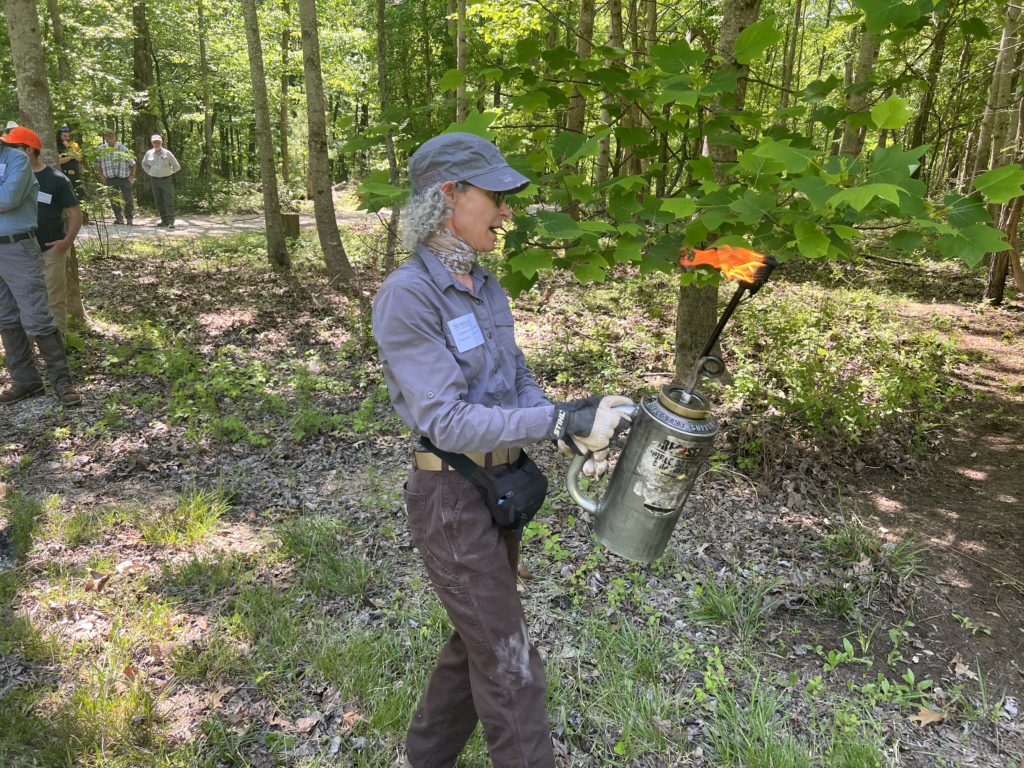Shortleaf Pine Restoration on the Cumberland Plateau
 Written by Shawn Swartz
Written by Shawn Swartz
The Southeast Region of the Forest Stewards Guild recently finished a multi-year project on the Cumberland Plateau of Kentucky and Tennessee focused on the restoration of shortleaf pine on public and private lands. Beginning in 2019, the project was funded by the National Fish and Wildlife Foundation (NFWF) and supported by the Natural Resources Conservation Service (NRCS) and saw the Guild partnering with the Tennessee Wildlife Federation (TWF), the Tennessee Department of Environment and Conservation, Berea College, and The University of the South at Sewanee. Shortleaf pine is a fire-adapted species associated with poor soils and frequent disturbance. Due to changes in how humans interact with the landscape, the presence of shortleaf pine is declining across much of its native range, as well as associated species such as the prairie warbler, pine warbler, and wild turkey.
 The project supported shortleaf pine restoration on private and public lands by conducting prescribed burns and other enhancement activities on over 4,000 acres, planting nearly 1,500 acres of shortleaf pine, and enhancing over 1,500 acres of shortleaf pine ecosystems. Additionally, the project supplied private landowners with shortleaf pine restoration plans, trained individuals in the use of prescribed fire using state and federal standards, and engaged in educating landowners, practitioners, and the public in the importance of prescribed fire through interpretive signage, workshops, and webinars.
The project supported shortleaf pine restoration on private and public lands by conducting prescribed burns and other enhancement activities on over 4,000 acres, planting nearly 1,500 acres of shortleaf pine, and enhancing over 1,500 acres of shortleaf pine ecosystems. Additionally, the project supplied private landowners with shortleaf pine restoration plans, trained individuals in the use of prescribed fire using state and federal standards, and engaged in educating landowners, practitioners, and the public in the importance of prescribed fire through interpretive signage, workshops, and webinars.
 This work is a continuation of an earlier project to build the foundation for increased capacity for shortleaf pine restoration on the Cumberland Plateau, bringing the total time we and our partners have engaged in this work to six years. The project weathered many significant challenges, such as staffing changes and of course, a global pandemic. The success of the effort is due to phenomenal, dedicated work toward project goals and partnerships that have grown over time and continue to mature, providing significant positive impacts that none of us could accomplish alone. The landscape, wildlife, and human communities in the region are richer for the actions of the collective work. In the future, we hope to extend our work on the Plateau to include white oak in addition to shortleaf pine. We appreciate the opportunity to engage in this effort with our partners.
This work is a continuation of an earlier project to build the foundation for increased capacity for shortleaf pine restoration on the Cumberland Plateau, bringing the total time we and our partners have engaged in this work to six years. The project weathered many significant challenges, such as staffing changes and of course, a global pandemic. The success of the effort is due to phenomenal, dedicated work toward project goals and partnerships that have grown over time and continue to mature, providing significant positive impacts that none of us could accomplish alone. The landscape, wildlife, and human communities in the region are richer for the actions of the collective work. In the future, we hope to extend our work on the Plateau to include white oak in addition to shortleaf pine. We appreciate the opportunity to engage in this effort with our partners.
